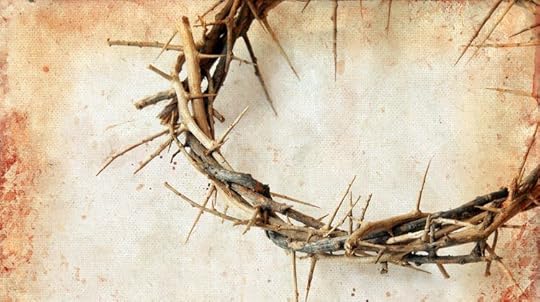The Way of Sorrows
 Last month I had the amazing privilege of touring the Cathedral of St. John the Baptist in Savannah, Georgia. It was a trip down memory lane and an opportunity to share with my closest friends some of the sacred experiences of my childhood growing up in the Catholic Church. The Savannah cathedral has some of the most intricate and beautiful Stations of the Cross I had ever seen, and as I explained their significant to my non-Catholic friends, I was reminded how powerful some of the rituals of my childhood faith truly were, though I did not appreciate them at the time. As a child in Catholic school, I spent my Lenten Fridays at each Station of the Cross until all 14 had been observed, acknowledged, and reverently prayed before. Like most of my classmates, I dreaded the experience--it was long, tedious and boring. Any attempt to speed up the process with skipped or rapidly uttered or abbreviated prayers was met with stern reproof from the teacher standing close by, especially if that teacher also happened to be a nun. What are the Stations of the Cross? If you didn't grow up in Catholic Church, this beautiful tradition may be unknown to you, but of all the things I now hold in my heart that helped shape in my childhood what my current relationship with God would become, the Catholic approach to Holy Week stands unparalleled. Spending every Holy Week of my childhood utterly fixated on the passion of Christ from Palm Sunday to Resurrection Sunday was both formative and transformative. As I stood in St. John the Baptist Cathedral in Savannah, staring up at the cathedral's breathtaking stations, I thanked God for putting me in front of those stations every Lenten Friday of my childhood because His passion became my own. For my fellow believers across and outside of the denominations, here's a primer and some interesting facts about the Stations of the Cross:The Stations of the Cross, also known as The Way of Sorrows, were developed as an alternative "journey" for believers when Jerusalem fell to the Muslims in 1187 and a pilgrimage to Jerusalem became untenable.Originally, these stations were placed outside along a path or roadway to align with the similar "stations" that corresponded to the actual landmarks of Christ's journey through Jerusalem to Calvary. They were referred to as Via Sacras, or sacred roads, for those who chose to travel them to and from a particular church. Over time, they moved indoors as a shorter, commemorative journey within a church or cathedral itself. There are traditionally 14 stations of the cross, the earliest set comprised eight scenes that aligned with the gospel accounts of the Passion, and six that followed the oral tradition of the church. But in 2007, Pope Benedict approved a set of stations that better aligned with the scriptural accounts of Christ's journeyAnyone taking a personal and prayerful walk through these stations would pause, reflect, and pray at each of these 14 scenes, meditating on the way of suffering--the Via Dolorosa--of Jesus:Jesus in the Garden of GethsemaneJesus is betrayed by Judas and arrestedJesus is condemned by the SanhedrinJesus is denied by PeterJesus is judged by PilateJesus is scourged and crowned with thornsJesus takes up his crossJesus is helped by Simon of Cyrene to carry his crossJesus meets the women of JerusalemJesus is crucifiedJesus promises his kingdom to the repentant thiefJesus entrusts Mary and John to each otherJesus dies on the crossJesus is laid in the tomb.Did you know?Mel Gibson's Passion of the Christ was intentionally written to follow these 14 stations, and if you watch the movie this Holy Week, you'll see that the movie follows the "Passion," or journey of suffering, of Jesus. My family will be sitting down to watch Passion of the Christ tonight, and I am grateful for the opportunity to reengage in the journey I took so often as a child--to truly consider and give thanks for every step my savior took to the cross...for me.
Last month I had the amazing privilege of touring the Cathedral of St. John the Baptist in Savannah, Georgia. It was a trip down memory lane and an opportunity to share with my closest friends some of the sacred experiences of my childhood growing up in the Catholic Church. The Savannah cathedral has some of the most intricate and beautiful Stations of the Cross I had ever seen, and as I explained their significant to my non-Catholic friends, I was reminded how powerful some of the rituals of my childhood faith truly were, though I did not appreciate them at the time. As a child in Catholic school, I spent my Lenten Fridays at each Station of the Cross until all 14 had been observed, acknowledged, and reverently prayed before. Like most of my classmates, I dreaded the experience--it was long, tedious and boring. Any attempt to speed up the process with skipped or rapidly uttered or abbreviated prayers was met with stern reproof from the teacher standing close by, especially if that teacher also happened to be a nun. What are the Stations of the Cross? If you didn't grow up in Catholic Church, this beautiful tradition may be unknown to you, but of all the things I now hold in my heart that helped shape in my childhood what my current relationship with God would become, the Catholic approach to Holy Week stands unparalleled. Spending every Holy Week of my childhood utterly fixated on the passion of Christ from Palm Sunday to Resurrection Sunday was both formative and transformative. As I stood in St. John the Baptist Cathedral in Savannah, staring up at the cathedral's breathtaking stations, I thanked God for putting me in front of those stations every Lenten Friday of my childhood because His passion became my own. For my fellow believers across and outside of the denominations, here's a primer and some interesting facts about the Stations of the Cross:The Stations of the Cross, also known as The Way of Sorrows, were developed as an alternative "journey" for believers when Jerusalem fell to the Muslims in 1187 and a pilgrimage to Jerusalem became untenable.Originally, these stations were placed outside along a path or roadway to align with the similar "stations" that corresponded to the actual landmarks of Christ's journey through Jerusalem to Calvary. They were referred to as Via Sacras, or sacred roads, for those who chose to travel them to and from a particular church. Over time, they moved indoors as a shorter, commemorative journey within a church or cathedral itself. There are traditionally 14 stations of the cross, the earliest set comprised eight scenes that aligned with the gospel accounts of the Passion, and six that followed the oral tradition of the church. But in 2007, Pope Benedict approved a set of stations that better aligned with the scriptural accounts of Christ's journeyAnyone taking a personal and prayerful walk through these stations would pause, reflect, and pray at each of these 14 scenes, meditating on the way of suffering--the Via Dolorosa--of Jesus:Jesus in the Garden of GethsemaneJesus is betrayed by Judas and arrestedJesus is condemned by the SanhedrinJesus is denied by PeterJesus is judged by PilateJesus is scourged and crowned with thornsJesus takes up his crossJesus is helped by Simon of Cyrene to carry his crossJesus meets the women of JerusalemJesus is crucifiedJesus promises his kingdom to the repentant thiefJesus entrusts Mary and John to each otherJesus dies on the crossJesus is laid in the tomb.Did you know?Mel Gibson's Passion of the Christ was intentionally written to follow these 14 stations, and if you watch the movie this Holy Week, you'll see that the movie follows the "Passion," or journey of suffering, of Jesus. My family will be sitting down to watch Passion of the Christ tonight, and I am grateful for the opportunity to reengage in the journey I took so often as a child--to truly consider and give thanks for every step my savior took to the cross...for me.
Published on March 30, 2018 14:05
No comments have been added yet.



